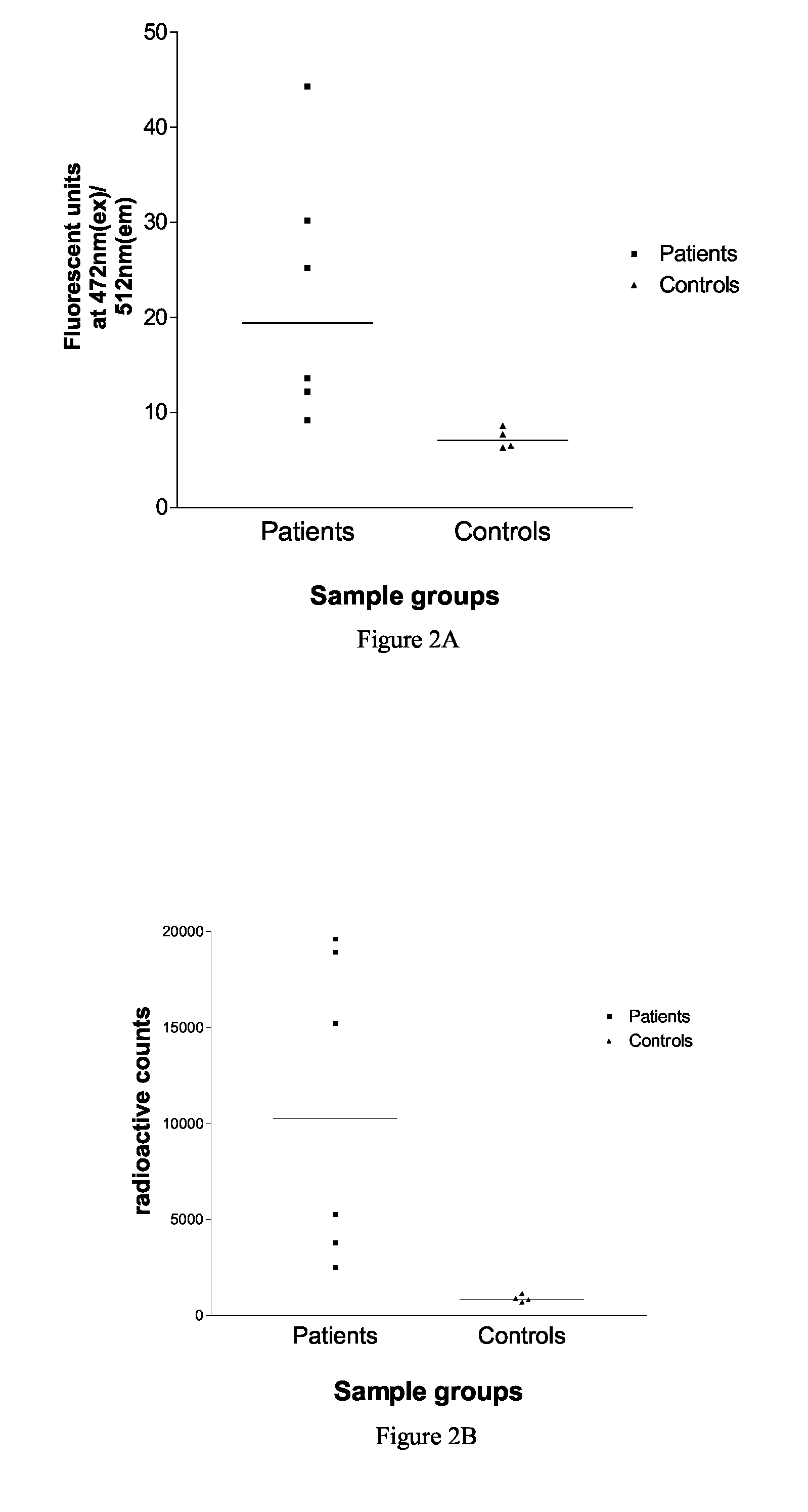Detection of Antibodies
a technology of antibodies and detection methods, applied in the field of detection of antibodies, to achieve the effect of high-efficiency methods
- Summary
- Abstract
- Description
- Claims
- Application Information
AI Technical Summary
Benefits of technology
Problems solved by technology
Method used
Image
Examples
example 1
An Assay for Serum Antibodies to AChR Using EGFP Tagged AChR α-, γ- and ε-Subunits
Methods
[0055]Construction of Plasmids that Express EGFP-Tagged Human AChR Subunits.
[0056]Oligonucleotides were designed to amplify 615 base pairs (a polypeptide tag of 205 amino acids) encoding the EGFP sequence tag, so that the tag fragment could be ligated “in frame” within the AChR subunit cDNA sequence. The site of insertion within the AChR subunit sequence was chosen to be within the intracellular cytoplasmic domain between transmembrane regions M3 and M4, but not within the MA amphipathic helix region.
[0057]Thus for the human AChR α subunit, oligonucleotides
5′-GCCGATATCATGGTGAGCAAGGGCGAGGAGC-3′and5′-CGCGATATCCTTGTACAGCTCGTCCATGCCGAGAGTGAT-3′
were used to amplify the EGFP sequence. The resulting fragment was cut with EcoR V and ligated into the α-subunit cDNA sequence at the EcoR V restriction site at position 1041. Following transformation, constructs were analysed and colonies isolated in which t...
example 2
An Assay for Serum Antibodies to Muscle-Specific Kinase (MuSK) Using a EGFP-Tagged MuSK
[0072]Serum antibodies to muscle-specific kinase (MuSK) underlie a form of myasthenia gravis in which antibodies to the AChR are absent. Diagnostic tests for anti-MuSK myasthenia gravis at present are performed by radio-labelling purified MuSK with 125Iodine, and using this radiolabelled antigen in standard immunoprecipitation assays. In a method according to the present invention, EGFP-tagged MuSK is synthesised and fluorescence-tagged immunoprecipitation is used as a method for detection of anti-MuSK antibodies in serum samples.
Method
[0073]HEK 293 cells were transiently transfected with the plasmid pSecTagA 1234MuSK-GFP, which is derived from the plasmid pSecTagC (Invitrogen), and which encodes the extracellular region of human MuSK (residues 22-473), a polyhistidine tag and EGFP. The secreted protein was harvested from cell growth medium (Cambrex UltraCHO) after 2 and 5 days. The protein was pu...
example 3
An Assay for Serum Antibodies to Aquaporin-4 (AQP4) Using a EGFP-Tagged AQP4
[0076]Although there are criteria laid down as a guide to differentiate between Multiple Sclerosis (MS) and Neuromyelitis Optica (NMO), they present with similar symptoms. An early difference in the pathogenesis of the two diseases seems to be the presence of detectable levels of autoantibodies to the water channel aquaporin-4 (AQP4) in about 65% of NMO patients. These autoantibodies have not been detected in MS patients. Because of the severity of NMO (Devic's disease) and the different treatment needed for the two diseases, an assay to differentiate them at an early stage would be of immense value. The principle behind this assay, which used immunohistochemical techniques, was published by Lennon et al. J Exp Med (2005) 202 (4): 473-7 and Weinshenker et al. Dis Markers. (2006) 22 (4):197-206.
[0077]Aquaporin 4 is a member of the aquaporin family of membrane water channels. It is abundantly expressed in the ...
PUM
| Property | Measurement | Unit |
|---|---|---|
| pH | aaaaa | aaaaa |
| excitation at wavelength | aaaaa | aaaaa |
| excitation at wavelength | aaaaa | aaaaa |
Abstract
Description
Claims
Application Information
 Login to View More
Login to View More - R&D
- Intellectual Property
- Life Sciences
- Materials
- Tech Scout
- Unparalleled Data Quality
- Higher Quality Content
- 60% Fewer Hallucinations
Browse by: Latest US Patents, China's latest patents, Technical Efficacy Thesaurus, Application Domain, Technology Topic, Popular Technical Reports.
© 2025 PatSnap. All rights reserved.Legal|Privacy policy|Modern Slavery Act Transparency Statement|Sitemap|About US| Contact US: help@patsnap.com



